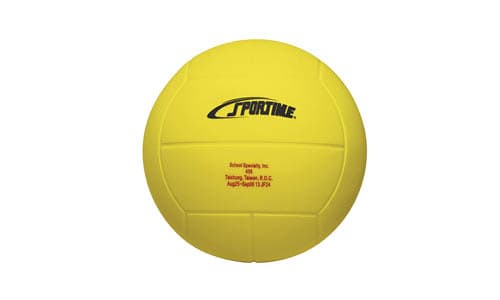Fall is coming and that means a whole new set of sports will be played on fields and courts around the US. Some of the most popular ones in America’s high schools and recreation leagues include cross-country, field hockey, tennis, volleyball, football, and basketball.
The following drills and mini-games will help your students prepare for volleyball. Volleyball is a fun and very active sport that takes teamwork, strength, agility, communication, and, depending on the level of play, the skills of passing, setting, spiking, and serving.



Shop All Volleyballs
8 Drills & Mini-Games for Building Volleyball Skills
The following 8 activities are designed to help your students build those skills, beginning with volleying and striking balloons in K-2, to learning the forearm pass in 3-6, applying skills into mini-games in middle school, and finally playing volleyball with a focus on various strategies in high school.
Keep It Up
This is a great activity to introduce volleying and striking to your K-2 students. Scatter students throughout the area (best indoors to avoid wind), each with a balloon, punchball, or beachball. Give some time to explore playing with their balloon and teach them what to do with it on your stop signal. Then introduce Keep It Up where the object is to keep the balloon in the air as long as they can by volleying it with various body parts. Add partner challenges to introduce volleying with another player.
The Shephard
Once your K-2 students can volley and strike their balloon with some control, try applying that skill to a little game called The Shephard. In this game, 3-5 students are designated as “sheep dogs” that stand in the center of the area. The other players line up on an endline, each with a balloon. They are the shepherds and their balloons are the sheep. The object is to volley their sheep continuously as they walk through the “pasture” without allowing a sheepdog to tap their sheep away.
Passing 21
For students in grades 3-6, introducing the volleyball forearm pass can be tricky. Allow students to use slower-moving balls such as volley trainers or even beachballs to allow them time to get into the correct position under the ball. In Passing 21, after you’ve taught the forearm pass (or bump), allow them to practice in small groups of 4-5 in a circle. Always begin with an underhand toss to someone in the group and have them practice keeping it up. The object is to score 21 with 3 points made for every pass made from the air and 1 point if it bounces.
Volleyball 4-Square
When your 3-6 graders have some control with their forearm passes and sets, Volleyball 4-Square is a fun way to practice those skills. Create a 4-square court with 2 students in each square. The object is to try to move to Square #1 by passing to other pairs in the square. When a pair makes an error (can’t pass the ball into another pair’s square), they move to Square #4 and all others move up a square. It is played like 4-square, but using volleyball passing, setting, and serving skills.
Volley Tennis
This is a fun activity for middle schoolers who are still developing their passing skills and want to play a game with their emerging skills. In Volley Tennis they play a mini 3V3 game using a low net (tennis height) or a line of cones. The object is for each player on a side to hit the ball (3 hits) before sending it over the net to the other group’s court. The ball may bounce between each hit if needed. Use a ball that has a decent bounce for this activity. Players may use passing, setting and serving skills. If they are ready, you can add the spike!
Mini-Volleyball
Once your students have the skills to hit the ball without a bounce, they are ready for Mini-Volleyball. This game involves 6 students per “court” where 2 hold a rope for a net, 2 are on one side of the net, and the final 2 on the other. They play for 10 serves or so, then switch net-holders. It’s super fun and challenging and an Extension makes it even more so, by challenging students to play without a bounce between hits. That is a great way to differentiate for students’ skill levels.
The 3rd Degree
When your high school students have their passing, setting, and hitting skills and are ready to apply them in a game setting, The 3rd Degree is a great one. This game focuses on using all 3 hits each time the ball is on one side of the net. In fact, they can only score by using the 3-hit sequence.
Royal Court Tournament
When your class has progressed and is ready for some competition with each other, try the Royal Court Tournament. This is appropriate from 5th through 12th grades. Whatever game you are playing, use this type of tourney to help students play others who are similarly skilled. In this tournament they play for a specified time period, say 5 minutes, and keep score. On the stop signal, if they were ahead, they move up one court closer to the “Royal” court. If they were behind, they move down. If tied, do a rock, paper, scissors to determine.

